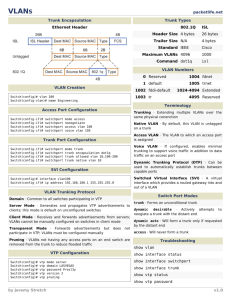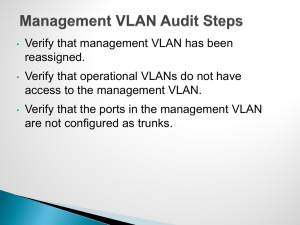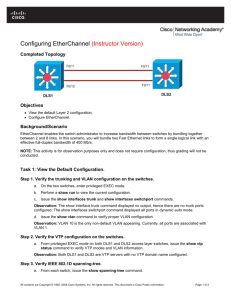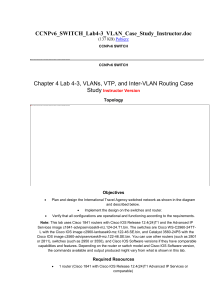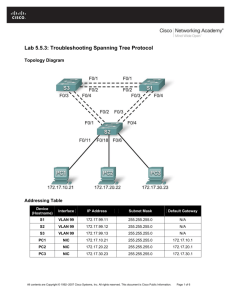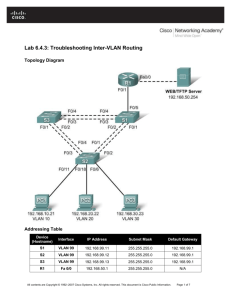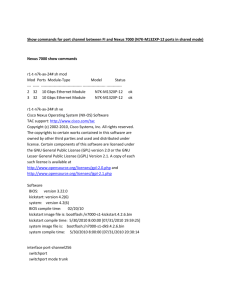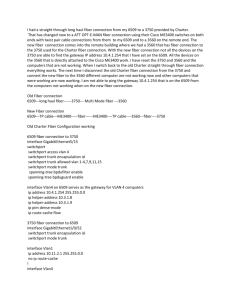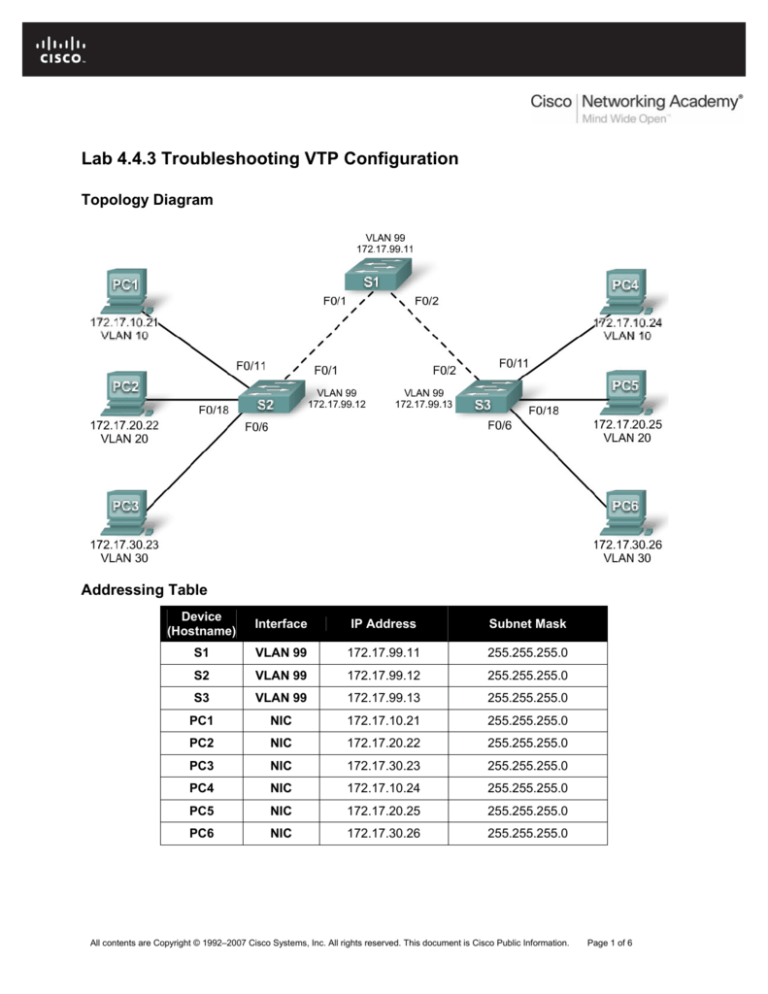
Lab 4.4.3 Troubleshooting VTP Configuration
Topology Diagram
Addressing Table
Device
(Hostname)
Interface
IP Address
Subnet Mask
S1
VLAN 99
172.17.99.11
255.255.255.0
S2
VLAN 99
172.17.99.12
255.255.255.0
S3
VLAN 99
172.17.99.13
255.255.255.0
PC1
NIC
172.17.10.21
255.255.255.0
PC2
NIC
172.17.20.22
255.255.255.0
PC3
NIC
172.17.30.23
255.255.255.0
PC4
NIC
172.17.10.24
255.255.255.0
PC5
NIC
172.17.20.25
255.255.255.0
PC6
NIC
172.17.30.26
255.255.255.0
All contents are Copyright © 1992–2007 Cisco Systems, Inc. All rights reserved. This document is Cisco Public Information.
Page 1 of 6
CCNA Exploration
LAN Switching and Wireless: VTP
Lab 4.4.3: Troubleshooting VTP Configuration
Port Assignments (Switches 2 and 3)
Ports
Fa0/1 – 0/5
Fa0/6 – 0/10
Fa0/11 – 0/17
Fa0/18 – 0/24
Assignment
802.1q Trunks (Native VLAN 99)
VLAN 30 – Guest (Default)
VLAN 10 – Faculty/Staff
VLAN 20 – Students
Network
172.17.99.0 /24
172.17.30.0 /24
172.17.10.0 /24
172.17.20.0 /24
Objectives
Upon completion of this lab, you will be able to:
•
Cable a network according to the topology diagram
•
Erase the startup configuration and vlan.dat files and reload switches to the default state
•
Load the switches with supplied scripts
•
Find and correct all configuration errors
•
Document the corrected network
Scenario
The VLAN Trunking Protocol (VTP) helps ensure uniform VLAN configurations on your switched network,
but it must be configured correctly. In this lab, you will use the supplied scripts to configure S1 as a VTP
server, and S2 and S3 as VTP clients. The VTP domain name is Lab4_3, and the VTP password is cisco.
However, there are a number of errors in this configuration that you must troubleshoot and correct before
end-to-end connectivity within the VLAN is restored.
You will have successfully resolved all errors when the same VLANs are configured on all three switches,
and you can ping between any two hosts in the same VLAN or between any two switches.
Task 1: Prepare the Network
Step 1: Cable a network that is similar to the one in the topology diagram.
You can use any current switch in your lab as long as it has the required interfaces shown in the topology
diagram. The output shown in this lab is based on 2960 switches. Other switch types may produce
different output. If you are using older switches, then some commands may be different or unavailable.
Set up console connections to all three switches.
Step 2: Clear any existing configurations on the switches.
Clear switch configurations and VLANs on all three switches and reload them to restore the default state.
Use the show vlan command to confirm that only default VLANs exist and that all ports are assigned to
VLAN 1.
Step 3: Configure the Ethernet interfaces on the host PCs.
Configure the Ethernet interfaces of PC1, PC2, PC3, PC4, PC5, and PC6 with the IP addresses indicated
in the addressing table at the beginning of the lab. There is no need to configure the default gateways for
this lab.
Task 2: Load Switches with Supplied Scripts
S1 Configuration
enable
All contents are Copyright © 1992–2007 Cisco Systems, Inc. All rights reserved. This document is Cisco Public Information.
Page 2 of 6
CCNA Exploration
LAN Switching and Wireless: VTP
Lab 4.4.3: Troubleshooting VTP Configuration
!
config term
hostname S1
enable secret class
no ip domain-lookup
!
vtp mode server
vtp domain Lab4_3
vtp password Cisco
!
vlan 99
name management
exit
!
vlan 10
name Faculty/Staff
exit
!
vlan 20
name Students
exit
!
vlan 30
name Guest
exit
!
interface FastEthernet0/1
switchport trunk native vlan 99
switchport mode trunk
!
interface FastEthernet0/2
switchport trunk native vlan 99
switchport mode access
!
interface FastEthernet0/3
switchport trunk native vlan 99
switchport mode access
!
interface FastEthernet0/4
switchport trunk native vlan 99
switchport mode trunk
!
interface FastEthernet0/5
switchport trunk native vlan 99
switchport mode trunk
!
interface range FastEthernet0/6-24
shutdown
!
interface GigabitEthernet0/1
shutdown
!
interface GigabitEthernet0/2
shutdown
!
interface Vlan99
All contents are Copyright © 1992–2007 Cisco Systems, Inc. All rights reserved. This document is Cisco Public Information.
Page 3 of 6
CCNA Exploration
LAN Switching and Wireless: VTP
Lab 4.4.3: Troubleshooting VTP Configuration
ip address 179.17.99.11 255.255.255.0
no shutdown
!
line con 0
logging synchronous
password cisco
login
line vty 0
no login
line vty 1 4
password cisco
login
line vty 5 15
password cisco
login
!
end
S2 Configuration
hostname S2
!
enable secret class
no ip domain-lookup
!
vtp mode client
vtp domain Lab4
!
!
interface FastEthernet0/1
switchport trunk native vlan 99
switchport mode access
!
interface FastEthernet0/2
switchport trunk native vlan 99
switchport mode access
!
interface FastEthernet0/3
switchport trunk native vlan 99
switchport mode trunk
!
interface FastEthernet0/4
switchport trunk native vlan 99
switchport mode trunk
!
interface FastEthernet0/5
switchport trunk native vlan 99
switchport mode trunk
!
interface range FastEthernet0/6 - 10
switchport access vlan 10
!
switchport mode access
!
interface range FastEthernet0/11 - 17
All contents are Copyright © 1992–2007 Cisco Systems, Inc. All rights reserved. This document is Cisco Public Information.
Page 4 of 6
CCNA Exploration
LAN Switching and Wireless: VTP
Lab 4.4.3: Troubleshooting VTP Configuration
switchport access vlan 20
switchport mode access
!
interface range FastEthernet0/18 - 24
switchport access vlan 30
switchport mode access
!
interface Vlan99
ip address 172.17.99.12 255.255.255.0
no shutdown
!
ip http server
!
line con 0
password cisco
logging synchronous
login
line vty 0 4
password cisco
login
line vty 5 15
password cisco
S3 Configuration
hostname S3
!
enable secret class
no ip domain-lookup
!
vtp mode client
vtp domain Lab4
!
!
interface FastEthernet0/1
switchport trunk native vlan 99
switchport mode trunk
!
interface FastEthernet0/2
switchport trunk native vlan 99
switchport mode trunk
!
interface FastEthernet0/3
switchport trunk native vlan 99
switchport mode trunk
!
interface FastEthernet0/4
switchport trunk native vlan 99
switchport mode trunk
!
interface FastEthernet0/5
switchport trunk native vlan 99
switchport mode trunk
!
interface range FastEthernet0/6 - 10
switchport access vlan 30
All contents are Copyright © 1992–2007 Cisco Systems, Inc. All rights reserved. This document is Cisco Public Information.
Page 5 of 6
CCNA Exploration
LAN Switching and Wireless: VTP
Lab 4.4.3: Troubleshooting VTP Configuration
switchport mode access
!
interface range FastEthernet0/11 - 17
switchport access vlan 10
switchport mode access
!
interface range FastEthernet0/18 - 24
switchport access vlan 20
switchport mode access
!
interface Vlan99
ip address 172.17.99.12 255.255.255.0
no shutdown
!
line con 0
password cisco
login
line vty 0 4
password cisco
login
line vty 5 15
password cisco
login
end
Task 3: Troubleshoot and Correct VTP and Configuration Errors
When all errors are corrected, you should be able to ping PC4 from PC1, PC5 from PC2, and PC6 from
PC3. You should also be able to ping the management interfaces on both S2 and S3 from S1.
Task 4: Document the Switch Configuration
When you have completed your troubleshooting, capture the output of the show run command and save
it to a text document for each switch.
Task 5: Clean Up
Erase the configurations and reload the switches. Disconnect and store the cabling. For PC hosts that are
normally connected to other networks (such as the school LAN or to the Internet), reconnect the
appropriate cabling and restore the TCP/IP settings.
All contents are Copyright © 1992–2007 Cisco Systems, Inc. All rights reserved. This document is Cisco Public Information.
Page 6 of 6


